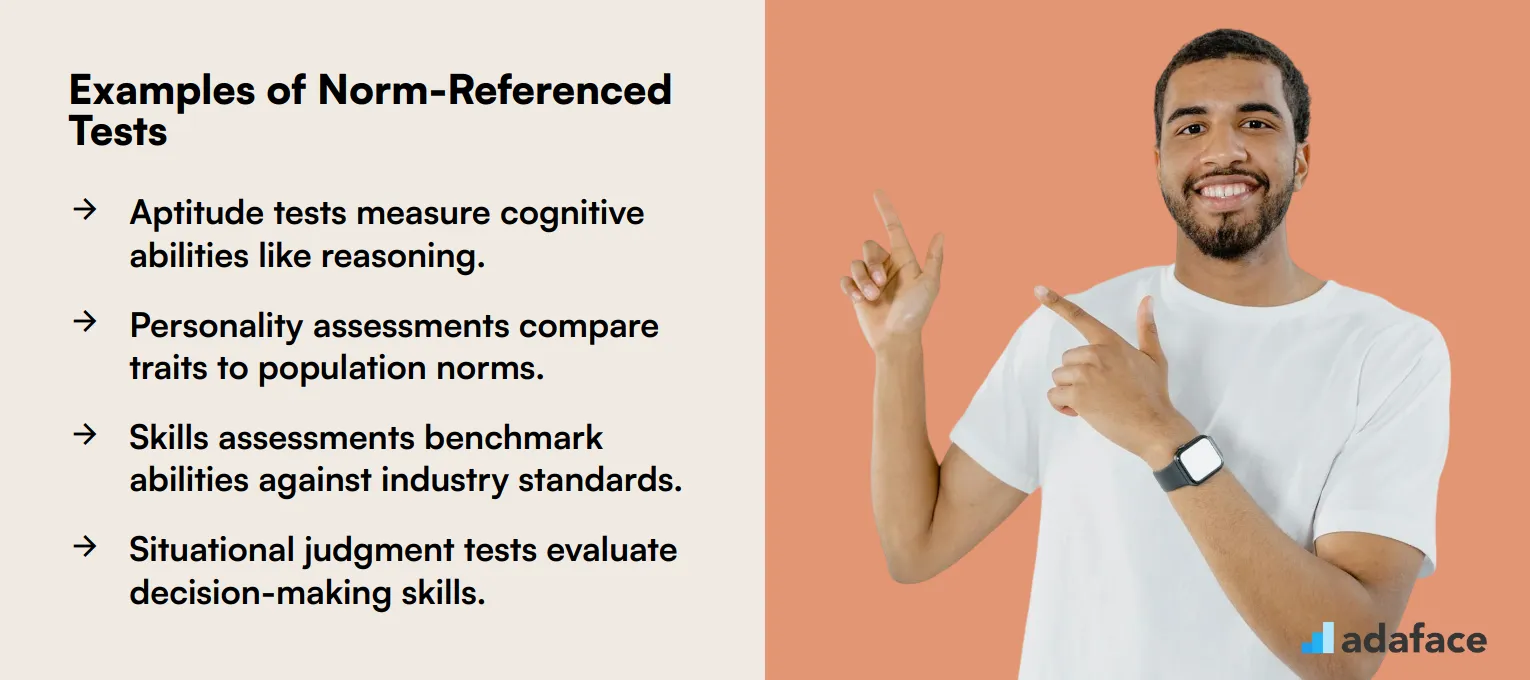Norm-referenced tests are powerful tools in a recruiter's arsenal. These assessments compare a candidate's performance to that of a norm group, providing valuable insights into their relative strengths and abilities.
By understanding how to effectively use and interpret norm-referenced tests, recruiters can make more informed hiring decisions. This guide will explore the ins and outs of norm-referenced testing in recruitment, helping you leverage these assessments for better talent acquisition.
Table of contents
What is a Norm-Referenced Test?
A norm-referenced test is a type of assessment designed to compare a test taker's performance against the performance of a group. This group, known as the norm group, serves as the benchmark for interpreting individual scores.
These tests are commonly used in educational settings but have significant applications in recruitment and HR. By comparing candidates' abilities to a standard group, recruiters can make informed decisions about potential hires.
Norm-referenced tests help identify top performers by measuring skills and abilities relative to others. This can be particularly useful in roles where specific skill levels are crucial.
Unlike criterion-referenced tests, which measure a candidate's performance against a fixed set of criteria, norm-referenced tests focus on ranking individuals. Understanding the difference between these tests is key for recruiters aiming to align their hiring strategies with organizational goals.
Incorporating such tests into the recruitment process can enhance the quality of hire and ensure that candidates meet the desired benchmarks. This approach allows for a more objective evaluation, reducing biases and improving the overall selection process.
Why Use Norm-Referenced Tests in Recruitment?
Norm-referenced tests are a powerful tool in recruitment, offering a way to compare a candidate's performance against a pre-established norm group. This method provides a clear picture of where a candidate stands in relation to others, helping recruiters make informed decisions about potential hires.
By using norm-referenced tests, recruiters can identify top performers more accurately. These tests help in distinguishing candidates who excel in specific skills or areas, making it easier to match them with suitable roles within the organization.
They also allow for a more objective evaluation process, reducing potential biases that can occur during traditional interviews. This objectivity ensures that the recruitment process is fair and that candidates are assessed based on their actual abilities.
Moreover, these tests can be tailored to measure specific competencies relevant to the job, ensuring that the most suitable candidates are selected. This targeted approach enhances the overall quality of hire, contributing to better team performance and productivity.
Incorporating norm-referenced tests into the recruitment process can also streamline the selection process. By efficiently narrowing down the candidate pool, recruiters can focus their efforts on the most promising candidates, saving time and resources.
Norm-Referenced vs. Criterion-Referenced Tests: What's the Diff?
Norm-referenced tests and criterion-referenced tests serve different purposes in the recruitment process. Norm-referenced tests compare an individual's performance to a group, providing a percentile ranking, while criterion-referenced tests measure a candidate's performance against a predefined standard or set of criteria.
In recruitment, norm-referenced tests are useful when you want to identify top performers relative to a peer group. They help in understanding where a candidate stands in comparison to others, which is beneficial for roles where relative performance is crucial.
On the other hand, criterion-referenced tests are ideal for assessing whether a candidate meets the specific requirements of a job. These tests are valuable when you need to ensure that candidates possess the necessary skills or knowledge to perform a role effectively, such as job knowledge tests.
Choosing between these tests depends on the recruitment goals and the nature of the job. For roles requiring a specific skill set, criterion-referenced tests provide a clear assessment of competency, while norm-referenced tests are better for identifying candidates who excel among their peers.
Understanding the difference between these tests can help recruiters and hiring managers make informed decisions when designing their assessment strategies. By aligning the test type with the recruitment objectives, organizations can improve their candidate experience and select the best-fit candidates for their roles.
Examples of Norm-Referenced Tests for Hiring
Norm-referenced tests are used across various sectors, and hiring is no exception. They provide a standardized way to compare candidates against each other. Let's look at some examples of how these tests can be used in recruitment.
One common example is aptitude tests. These tests measure a candidate's cognitive abilities, such as verbal reasoning, numerical reasoning, and abstract reasoning. The scores are then compared to a norm group to see how the candidate performs relative to others.
Another example is personality assessments, like the Big Five personality traits. While not always strictly norm-referenced, many personality tests provide scores that are compared against a general population. This helps recruiters understand a candidate's behavioral tendencies and how they might fit into the team.
Skills assessments can also be norm-referenced. For example, a typing test might compare a candidate's typing speed and accuracy against the average scores of professionals in similar roles. This provides a benchmark for evaluating a candidate's skill level.
Finally, consider situational judgment tests. These tests present candidates with realistic workplace scenarios and ask them to choose the best course of action; the responses are then scored against a norm group to determine how well the candidate's judgment aligns with successful employees. Using these tests helps in making informed hiring decisions.

Interpreting Norm-Referenced Test Scores: A Simple Guide
Interpreting norm-referenced test scores can be straightforward if you understand the basics. These scores are designed to compare an individual's performance to a group, often a national sample, to see where they stand relative to others.
A percentile rank is a common way to express these scores. If a candidate scores in the 75th percentile, it means they performed better than 75% of the reference group, offering a clear picture of their standing.
It's important to know that these scores don't measure the candidate's absolute ability, but rather their position in a distribution. This can be particularly useful in screening candidates when you want to quickly assess where they fall in comparison to others.
While interpreting these scores, consider the context and the specific group used for comparison. A score that seems low in one context might be high in another, depending on the reference group used.
Finally, remember that norm-referenced scores should be just one part of a comprehensive assessment strategy. Combining them with other methods like interviews or behavioral assessments can give a more rounded view of a candidate's potential.
Benefits and Limitations of Norm-Referenced Tests
Norm-referenced tests offer several advantages in recruitment and HR processes. They provide a standardized way to compare candidates against a larger population, helping identify top performers and potential high achievers.
One key benefit is the ability to rank candidates objectively based on their scores. This can streamline decision-making and reduce bias in the selection process, especially when dealing with a large applicant pool.
However, norm-referenced tests also have limitations. They may not always reflect job-specific skills or cultural nuances, potentially overlooking qualified candidates who don't fit the norm.
Another drawback is that these tests can sometimes favor certain groups, leading to unintended discrimination. It's crucial to use them as part of a comprehensive assessment strategy rather than relying on them exclusively.
Despite these limitations, when used appropriately, norm-referenced tests can be valuable tools in the recruitment process. They can provide useful data points to complement other assessment methods and inform hiring decisions.
Conclusion
Norm Referenced Test FAQs
Norm-referenced tests offer several advantages in hiring:
- Provide objective comparisons between candidates
- Help identify top performers relative to a larger population
- Allow for consistent evaluation across different roles and departments
- Assist in predicting job performance based on standardized metrics
Norm-referenced tests compare candidates to a norm group, while criterion-referenced tests measure against specific criteria:
- Norm-referenced: Evaluate relative performance (e.g., percentile ranks)
- Criterion-referenced: Assess absolute performance (e.g., pass/fail)
- Norm-referenced are better for comparing candidates; criterion-referenced for measuring specific skills
Common norm-referenced tests in recruitment include:
- Cognitive ability tests (e.g., verbal reasoning, numerical reasoning)
- Personality assessments (e.g., Big Five, DISC)
- Situational judgment tests
- Skills-based assessments (e.g., coding tests, language proficiency) Choose tests that align with job requirements and organizational needs.
To interpret norm-referenced test scores:
- Understand the scoring scale (e.g., percentiles, stanines)
- Compare scores to the relevant norm group
- Consider the job requirements and how they relate to the tested abilities
- Use scores as part of a holistic evaluation, not as the sole decision factor
Limitations of norm-referenced tests include:
- May not capture all job-relevant skills or qualities
- Norm groups might not always represent your target candidate pool
- Can be affected by test anxiety or unfamiliarity with test formats
- Overreliance on scores may lead to overlooking other important factors Use these tests as part of a comprehensive hiring process.

40 min skill tests.
No trick questions.
Accurate shortlisting.
We make it easy for you to find the best candidates in your pipeline with a 40 min skills test.
Try for freeRelated terms



